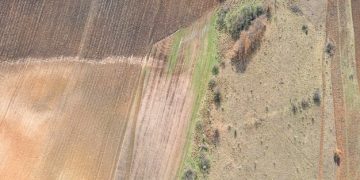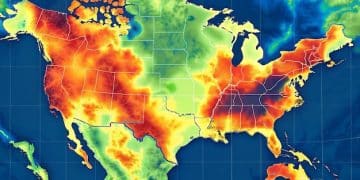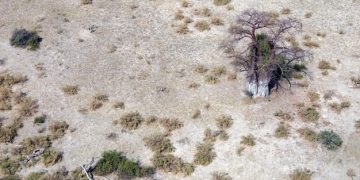Climate Change’s Impact on US Infrastructure: Roads & Bridges Stability
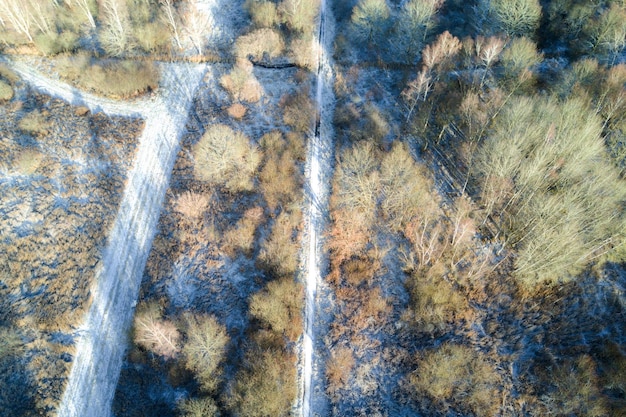
Climate change significantly impacts the stability of US infrastructure, particularly roads and bridges, through extreme weather events, rising temperatures, and sea-level rise, necessitating resilient designs and substantial investment to mitigate widespread disruption.
Understanding how does climate change affect the stability of US infrastructure, such as roads and bridges, is no longer a distant theoretical exercise but an urgent practical challenge. As weather patterns intensify and temperatures rise, the very foundations of our daily lives—our transportation networks—face unprecedented stressors. It’s crucial to grasp the multifaceted ways these changes threaten our vital systems.
The escalating threat of extreme weather events
Extreme weather events, from relentless heatwaves to torrential downpours and devastating hurricanes, are becoming more frequent and severe across the United States. These events pose a direct and escalating threat to the structural integrity and operational capacity of the nation’s vast network of roads and bridges. The engineering and design standards of much existing infrastructure were simply not conceived with the current or projected intensity of these phenomena in mind.
Consider the impact of intensified rainfall. Increased precipitation leads to more frequent and severe flooding, which can rapidly erode bridge foundations, compromise roadbeds, and inundate underpasses, making them impassable. Water seeping into pavement layers can weaken the bonding materials, leading to premature deterioration, potholes, and cracking. Beyond mere inconvenience, prolonged closures of key transportation arteries can cripple local economies, disrupt supply chains, and impede emergency services.
Flooding and storm surges
Coastal and low-lying regions are particularly vulnerable to flooding exacerbated by climate change. Storm surges from stronger hurricanes push seawater far inland, submerging roads and bridges not designed to withstand saline conditions or sustained submersion. This saltwater intrusion can accelerate corrosion in steel components of bridges and erode asphalt and concrete surfaces. The repetitive cycle of inundation and drying can also weaken sub-surface materials, leading to long-term structural fatigue.
- Erosion: Increased water flow can wash away soil supporting roadbeds and bridge abutments.
- Submersion: Prolonged inundation causes material degradation and operational closures.
- Saltwater Corrosion: Coastal infrastructure is vulnerable to corrosive effects of saline water.
- Scour: Fast-moving water around bridge piers can deepen channels, undermining foundations.
Inland river systems also face heightened flood risks from increased snowmelt and rainfall. Historical flood plains are expanding, engulfing roads and bridges once thought to be safely above water levels. The sheer volume and velocity of water can exert immense pressure on structures, leading to physical damage or complete collapse. The cumulative effect of these events places an enormous burden on state and local transportation agencies, stretching maintenance budgets and prolonging recovery efforts.
Rising temperatures and their thermal toll
The insidious rise in global temperatures, a hallmark of climate change, exacts a significant thermal toll on transportation infrastructure. Roads and bridges, primarily constructed from asphalt, concrete, and steel, are highly susceptible to temperature fluctuations. These materials expand when heated and contract when cooled, and extreme heat intensifies these natural processes, leading to accelerated degradation.
Asphalt pavements, for instance, become softer and more pliable under extreme heat, making them prone to rutting, shoving, and bleeding of the asphalt binder. This not only reduces the lifespan of the road surface but also creates an uneven driving surface that can compromise vehicle safety. Conversely, rapid cooling or repeated freeze-thaw cycles can cause asphalt to become brittle and crack, leading to potholes and surface erosion. The continuous cycle of expansion and contraction creates internal stresses that accelerate material fatigue.
Heat-induced expansion and contraction
Bridges face similar challenges. Steel components of bridge decks and trusses expand dimensionally during heatwaves. While bridges are generally designed with expansion joints to accommodate these movements, unusually high temperatures can exceed these design tolerances. This can cause joints to seize, buckle, or transmit excessive stress to adjacent structural elements, potentially leading to cracking in concrete decks or deformation of steel girders. The integrity of crucial fasteners and connections can also be compromised.
- Asphalt rutting: Extreme heat causes pavement to deform under traffic load.
- Concrete cracking: Thermal expansion and contraction induce stress fractures.
- Bridge joint failure: Excessive heat can cause expansion joints to fail or deform.
- Steel deformation: High temperatures can stress and warp steel components.
Moreover, the increased frequency of high-temperature extremes can also impact the performance of subsidiary systems. Traffic light signals, street lighting, and intelligent transportation system (ITS) equipment can overheat, leading to malfunctions and operational disruptions. The need for more robust, heat-resistant materials and adaptive design strategies becomes paramount to ensure the continued functionality and safety of infrastructure in a hotter climate.
Sea-level rise and coastal vulnerability
The relentless march of sea-level rise represents a profound long-term threat to coastal infrastructure in the United States. As global temperatures climb, glaciers and ice sheets melt, and ocean waters expand, leading to an inexorable rise in sea levels. This phenomenon directly impacts miles of roads, numerous bridges, and critical interconnected infrastructure systems located along the nation’s vast coastlines.
Coastal roads and bridges, many of which were built decades ago without considering future sea-level projections, are increasingly susceptible to permanent inundation. This isn’t just about daily high tides but also about the increased frequency and severity of “nuisance flooding,” where even minor tidal events cause significant portions of roadways to become impassable. Over time, these temporary disruptions can become permanent, rendering roads unusable and isolating communities.
Permanent inundation and saltwater intrusion
Beyond direct submersion, rising sea levels exacerbate the threat of saltwater intrusion into freshwater aquifers and subsurface infrastructure. This can compromise the foundations of roads and bridges built on low-lying ground, accelerating the corrosion of supporting structures and destabilizing soil integrity. The repeated exposure to saline water, especially in conjunction with storm surges, significantly reduces the operational lifespan of concrete and steel components, necessitating more frequent and costly repairs or complete replacements.
- Loss of access: Roads become permanently submerged, cutting off communities.
- Accelerated corrosion: Saltwater increases decay of bridge steel and concrete.
- Foundation instability: Saturated soils and erosion undermine structural support.
- Increased maintenance costs: More frequent and extensive repairs become necessary.
The implications are far-reaching, extending beyond just physical damage. Coastal communities rely heavily on these transportation arteries for economic activity, tourism, and access to essential services. The loss or impairment of these vital links could have cascading socio-economic consequences, displacing populations, disrupting commerce, and increasing the burden on emergency response efforts. Strategic planning, including relocation, elevation, or armored protection, is becoming critical for the survival of this infrastructure.
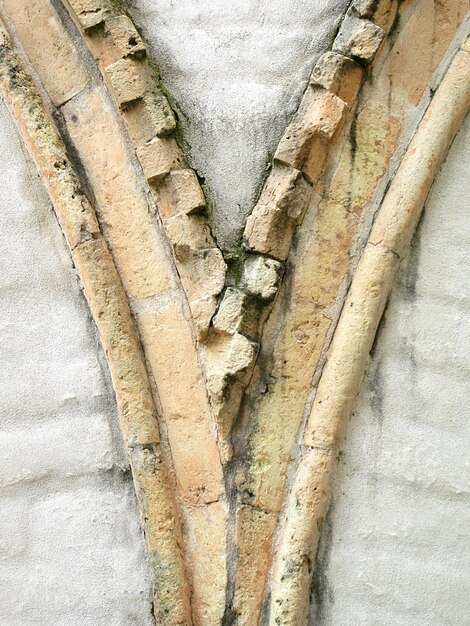
Aging infrastructure and compounding vulnerabilities
The challenge of climate change is significantly compounded by the pre-existing condition of much of the United States’ infrastructure: it is aging and, in many cases, already past its intended design life. Decades of underinvestment in maintenance, repair, and modernization have left a substantial portion of roads and bridges in a state of disrepair. This inherent vulnerability means these structures are less resilient to the added stresses imposed by a changing climate.
Many bridges across the U.S. were built in the mid-20th century, designed to withstand the traffic loads and environmental conditions prevalent at that time. These designs did not account for the significantly increased vehicular weights of modern freight, nor did they anticipate the frequency and intensity of today’s extreme weather events. Consequently, these older structures exhibit reduced capacity to absorb additional climate-induced pressures.
Maintenance backlogs and design limitations
The deferred maintenance backlog, estimated to be in the hundreds of billions of dollars, means that many roads already suffer from potholes, cracks, and weakened subgrades, making them more susceptible to rapid deterioration from heavy rainfall or extreme heat. Similarly, older bridges may have outdated design specifications for scour protection, seismic resilience, or thermal expansion, leaving them exposed to risks that newer structures might better handle. Retrofitting these structures to meet contemporary standards and climate resilience goals is a monumental and costly undertaking.
- Material fatigue: Older materials are more susceptible to climate stressors.
- Outdated standards: Designs predate current climate change understanding.
- Underinvestment: Decades of neglected maintenance reduce resilience.
- Cascading failures: Localized failures can lead to widespread network disruption.
Furthermore, the cumulative effect of minor, repeated climate-related stresses can lead to progressive and often unseen damage in aging infrastructure. What might be reparable damage in a new structure could be the tipping point for an older, already weakened one. This interaction between aging infrastructure and climate change creates a cycle of vulnerability, where climate impacts accelerate decay, and the degraded state of infrastructure amplifies the consequences of climate events.
Economic and societal ramifications
The physical degradation and failure of roads and bridges due to climate change extend far beyond immediate structural damage; they trigger a cascade of severe economic and societal ramifications. The efficiency and reliability of a nation’s transportation network are inextricably linked to its economic vitality and the daily lives of its citizens. When this network is compromised, the ripple effects are felt across multiple sectors.
Economically, disruptions to roads and bridges can severely impede commerce. Freight transport, which relies heavily on these networks, faces delays, increased fuel consumption due to longer routes, and higher operational costs. This trickles down to consumers in the form of higher prices for goods and services. Businesses, particularly those reliant on just-in-time delivery or tourism, can suffer significant financial losses. Agricultural products might spoil without timely market access, and manufacturing operations could halt due to supply chain breaks.
Disrupted connectivity and community impacts
Socially, the implications are equally profound. Road and bridge closures isolate communities, directly impacting residents’ ability to commute to work, attend school, access healthcare facilities, and receive emergency services. During natural disasters, damaged infrastructure can hinder evacuation routes and delay critical humanitarian aid and rescue operations. This can lead to increased hardship, reduced quality of life, and, in severe cases, loss of life. Entire regions can become disconnected, disrupting social networks and community cohesion.
- Supply chain disruption: Delays and increased costs for goods transport.
- Economic losses: Impact on businesses, tourism, and agricultural sectors.
- Emergency service delays: Hindered access for first responders.
- Reduced quality of life: Impaired access to work, education, and healthcare.
The fiscal burden of repairing and rebuilding damaged infrastructure is also immense, often stretching state and federal budgets already constrained by other priorities. These rebuilding efforts divert resources that could otherwise be allocated to new infrastructure development or other public services. Moreover, the hidden costs of climate change on infrastructure, such as decreased property values in flood-prone areas or increased insurance premiums, contribute to a long-term economic drain. Developing resilient infrastructure requires a forward-looking economic approach that values long-term prevention over costly reactive measures.
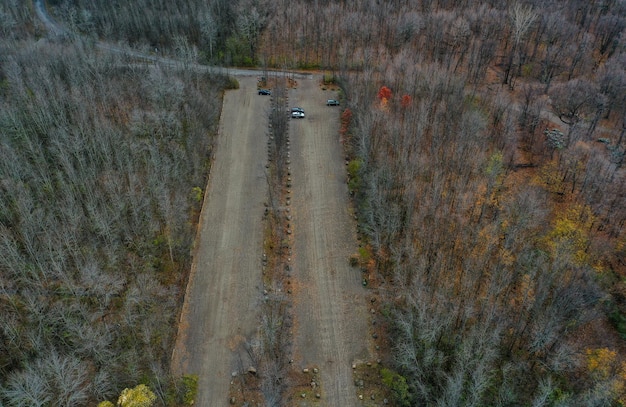
Building resilience: strategies and challenges
Confronting the multifaceted threats posed by climate change on US infrastructure requires a proactive and comprehensive approach focused on building resilience. This involves not only repairing existing damage but fundamentally rethinking how roads and bridges are designed, constructed, and maintained. The goal is to create infrastructure that can withstand, adapt to, and recover quickly from the impacts of a changing climate, minimizing disruptions and long-term costs.
One primary strategy involves updating design standards to incorporate future climate projections. This means building roads and bridges to higher elevations, using more robust materials resistant to extreme temperatures and corrosion, and designing drainage systems capable of handling increased precipitation and storm surges. For bridges, this might include deeper foundations to resist scour or more flexible connections to accommodate greater thermal expansion. Incorporating nature-based solutions, such as permeable pavements and restored wetlands, can also enhance resilience by improving natural drainage and reducing the impact of storm runoff.
Adaptive design and smart infrastructure
Beyond physical design, leveraging advanced technologies and “smart” infrastructure concepts offers significant promise. Real-time monitoring systems can provide early warnings of structural stress or impending failures, allowing for timely interventions. Predictive modeling, based on climate data, can help identify vulnerable areas and prioritize investments. Furthermore, focusing on modular construction techniques can enable faster repairs and replacements after extreme events, reducing prolonged downtime.
- Updated design standards: Incorporating climate projections into new builds.
- Material innovation: Utilizing stronger, more climate-resistant construction materials.
- Nature-based solutions: Employing natural systems to enhance resilience.
- Monitoring and data analytics: Using technology for early detection and predictive maintenance.
However, implementing these strategies faces considerable challenges. The sheer scale of the existing US infrastructure network means that upgrading all vulnerable assets is an enormous and costly undertaking, requiring significant, sustained investment from federal, state, and local governments. Political will, public support, and innovative financing mechanisms are crucial. Bridging the gap between scientific climate projections and actionable engineering solutions, as well as overcoming institutional inertia, also presents formidable hurdles. Yet, the long-term costs of inaction far outweigh the investments needed for resilient infrastructure.
| Key Impact | Brief Description |
|---|---|
| 🌧️ Extreme Weather | Increased flooding and intense storms erode foundations, damage roadbeds, and cause closures. |
| 🌡️ Rising Temperatures | Heat causes asphalt to deform and concrete/steel to expand, leading to cracks and structural stress. |
| 🌊 Sea-Level Rise | Coastal roads and bridges face inundation, saltwater corrosion, and destabilized foundations. |
| 🚧 Aging Infrastructure | Existing structures are often ill-equipped to handle modern climate stressors due to age and underinvestment. |
Frequently Asked Questions
▼
Asphalt pavements soften and rut under extreme heat, becoming brittle in colder temperatures. Concrete expands and contracts, leading to cracking, especially with cycles of heating and freezing. Steel components, crucial for bridge structures, are susceptible to thermal expansion and accelerated corrosion from saltwater intrusion, particularly in coastal areas hit by sea-level rise.
▼
Increased flooding and intense rainfall cause scour, where fast-moving water erodes the soil around bridge piers, undermining their structural support. Rising sea levels and coastal storm surges lead to saltwater intrusion, which accelerates corrosion of metallic foundations and can saturate supporting soils, compromising their load-bearing capacity and overall stability.
▼
While coastal systems face direct threats from sea-level rise and storm surges, inland infrastructure is highly vulnerable to other climate impacts. Increased extreme rainfall can cause riverine flooding and flash floods, leading to washouts and erosion of roads and bridges. Intense heatwaves can damage asphalt and cause thermal expansion issues in bridges, regardless of proximity to the coast.
▼
Nuisance flooding, also known as “sunny-day flooding,” refers to minor coastal flooding caused by increasingly high tides, often exacerbated by sea-level rise, rather than heavy rainfall. It frequently inundates low-lying coastal roads, causing traffic disruptions, slower commutes, and increased wear and tear on pavements due to prolonged saltwater exposure, eventually leading to permanent unsuitability.
▼
Strategies include updating design standards to account for future climate projections, utilizing more climate-resistant materials, elevating vulnerable roads, and enhancing drainage systems. Incorporating nature-based solutions like permeable pavements and restored wetlands can help. Additionally, implementing smart infrastructure technologies for real-time monitoring and predictive maintenance can improve overall resilience and response capabilities.
Conclusion
The stability of US infrastructure, particularly its vital network of roads and bridges, is undeniably and profoundly affected by the escalating impacts of climate change. From the relentless assault of extreme weather events and the insidious degradation caused by rising temperatures to the irreversible march of sea-level rise, these interconnected threats demand urgent and sustained attention. Compounded by an aging legacy infrastructure system often operating beyond its design life, the vulnerabilities are extensive. Addressing this challenge requires a fundamental shift towards resilient design, innovative material use, and substantial, long-term investment. Proactive adaptation is not merely a matter of economic prudence but a critical imperative for ensuring the safety, connectivity, and prosperity of communities across the nation.

